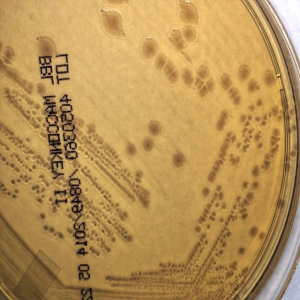Risk factors matter: case report of Y. pseudotuberculosis in obese patient

Accepted: 23 September 2022
HTML: 12
All claims expressed in this article are solely those of the authors and do not necessarily represent those of their affiliated organizations, or those of the publisher, the editors and the reviewers. Any product that may be evaluated in this article or claim that may be made by its manufacturer is not guaranteed or endorsed by the publisher.
Yersinia pseudotuberculosis is a Gram-negative bacillus that can occasionally cause zoonosis. Infections of this bacterium typically present as self-limiting ileitis, often accompanied by diarrhea, but, especially in the case of immunocompromised patients, can also lead to serious secondary complications which, if not treated properly, can progress with a poor prognosis. Here, we present a case of successfully treated bacteremia due to Y. pseudotuberculosis in a multipathological obese patient. The diagnosis was possible through blood culture, and this highlights the importance of the search for unconventional pathogens, especially in certain categories of patients whose risk factors are strongly indicative and suggestive.
Delchier JC, Constantini D., Soule JC. Presence of anti-Yersinia pseudotuberculosis agglutinins during a flare-up of ileal Crohn's disease. Apropos of 3 cases. Gastroenterol Clin Biol 1983;7:580-4.
Fukushima H, Gomyoda M, Ishikura S, et al. Cat-contaminated environmental substances lead to Yersinia pseudotuberculosis infection in children. J Clin Microbiol 1989;27:2706–09. DOI: https://doi.org/10.1128/jcm.27.12.2706-2709.1989
Galindo CL, Rosenzweig JA, Kirtley ML, et al. Pathogenesis of Y. enterocolitica and Y. pseudotuberculosis in Human Yersiniosis. J Pathogens 2011;2011:182051. DOI: https://doi.org/10.4061/2011/182051
Hashimoto T, Takenaka R, Fukuda H, et al. Septic shock due to Yersinia pseudotuberculosis infection in an adult immunocompetent patient: a case report and literature review. BMC Infect Dis. 2021;7;21:36. DOI: https://doi.org/10.1186/s12879-020-05733-w
Huttunen R, Syrjänen J. Obesity and the risk and outcome of infection. Int J Obes (Lond) 2013;37:333-40. DOI: https://doi.org/10.1038/ijo.2012.62
Jiang C, Chen Q, Xie M. Smoking increases the risk of infectious diseases: A narrative review. Tob Induc Dis. 2020;14:18-60. DOI: https://doi.org/10.18332/tid/123845
Lee YJ, Kim J, Jeon JH, et al. Extraintestinal Manifestation of Yersinia pseudotuberculosis Bacteremia as Acute Hepatitis: Case Report and Review of the Literature. Pathogens 2021;28;10:1255. DOI: https://doi.org/10.3390/pathogens10101255
Mead PS. “231-Yersinia Species (Including Plague)”, in Mandell, Douglas, and Bennett’s Principles and Practice of Infectious Diseases, 8th ed.”, Elsevier, 2015. DOI: https://doi.org/10.1016/B978-1-4557-4801-3.00231-9
Stecher B. The Roles of Inflammation, Nutrient Availability and the Commensal Microbiota in Enteric Pathogen Infection. Microbiol Spectr. 2015;3. DOI: https://doi.org/10.1128/microbiolspec.MBP-0008-2014
Supporting Agencies
NoneCopyright (c) 2022 the Author(s)

This work is licensed under a Creative Commons Attribution-NonCommercial 4.0 International License.
PAGEPress has chosen to apply the Creative Commons Attribution NonCommercial 4.0 International License (CC BY-NC 4.0) to all manuscripts to be published.


 https://doi.org/10.4081/mm.2022.10784
https://doi.org/10.4081/mm.2022.10784



